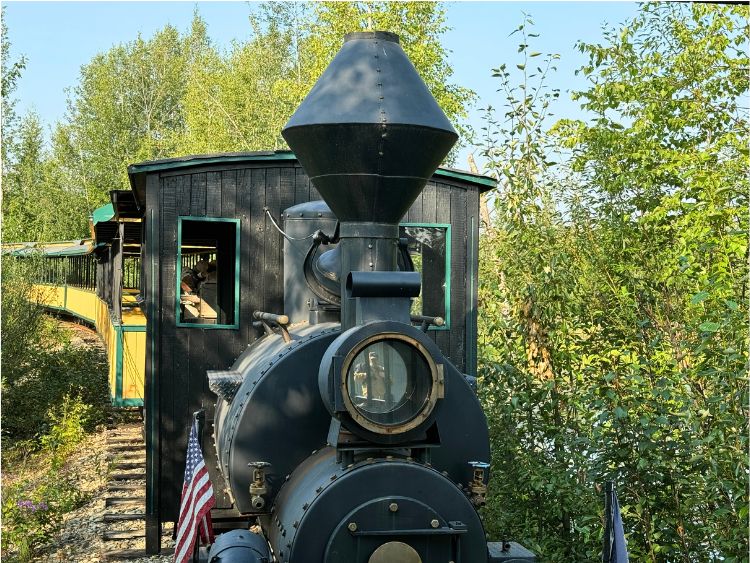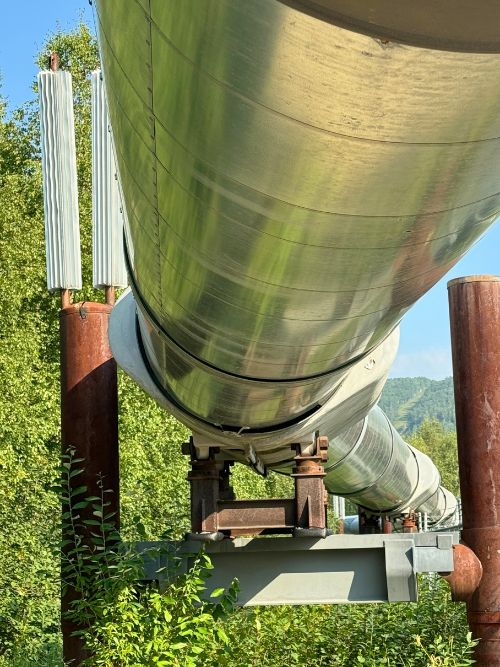
Go World Travel is reader-supported and may earn a commission from purchases made through links in this piece.
Gold was discovered in the Fairbanks area in 1902 when Italian immigrant Felix Pedro struck it rich. He put Fairbanks on the map and thousands of men rushed to interior Alaska in search of the precious yellow metal. They were driven by gold fever and the chance to stake their claims, often enduring harsh conditions amid a rugged landscape.
By 1930, though, small mines were replaced by large-scale mechanized mining and dredging operations. To this day, the region continues to be a productive gold mining area and a force in Alaska’s economy.
Head into the Heart of the Gold Fields on a Tour of Gold Dredge 8

To learn more about the history of gold mining in Interior Alaska, take a two-hour tour of Gold Dredge 8 in Fairbanks. Hop aboard a narrow-gauge train, a replica of those used on the Tanana Valley Railroad, which once served over two dozen gold camps throughout the area.
As the train takes you to into the heart of the gold fields of the Tanana Valley, history comes alive. Entertaining narrators talk about the story of gold in the area and give a history of placer and drift mining. They also talk about the techniques used to prep the ground for the Dredge and how it all works.
Read More: Top 10 Reasons to Visit Fairbanks, Alaska in the Winter
Gold Dredge 8 Facts

The Dredge operated between 1928-1959. During this period, it reaped 600,000 ounces of gold worth over $20 million. It closed for a few reasons; mainly, that the profits declined and more mining regulations were put into place when Alaska became a state in 1958. Large-scale extraction was deemed invasive, leaving behind significant environmental damage. Gold dredging later became illegal in the country.
Through the narration, you’ll get accustomed to a new vocabulary with words like sluice-box, drift mining, kibble, tailings, mica, pay dirt, poke sack, and more – a lexicon that you can use to impress your friends back home!
Best Tips & Tools to Plan Your Trip
When you see the Dredge, you’ll be taken aback at its ginormous size. With a steel hull, shaped like a ship, this machine measures 99-feet long and 50-feet wide. It was a masterpiece of engineering for its time and known to be very efficient in recovering gold, specifically the gold left behind by early drift miners. These men would dig vertical shafts to bedrock, then follow the drift of underground gold-bearing creeks.
Only six men were needed to operate the Dredge, with two of them oilers, whose job required them to continuously oil every piece of the machine during their twelve-hour shifts. The process of a dredge can be summarized in three basic steps: chew up the ground, swallow the gold and spit out the rock.
Watch a Gold Panning Demo

As the train nears the main camp, panning instructors demonstrate the gold panning process. The principal is simple. Gold is heavy and just about everything else is lighter in weight. When you load a pan of gold-bearing gravel and sand and agitate/shaking it in the water, the gold will sink to the bottom and the lighter stuff will rise to the top and be washed away. After dipping and agitating repetitively, all that remains is the heaviest minerals – hopefully some gold.
Read More: Alaska History and Native Cultures Come Alive at These Anchorage Museums
Try Panning for Yourself

Once in camp, you’ll receive your own poke sack of pay-dirt, with the guarantee that everyone will be successful in their panning endeavors. I liked those odds!
Though the panning process looked relatively easy when I watched the demonstrators, I quickly learned that it requires finesse and patience. I had patience, but my finesse needed work.
You can keep all of the gold you find, then take it to the measuring station to find out its weight and worth. The reward for my efforts came to $26. Not enough to get rich, but enough to put into a locket as a reminder of my panning experience!
Tour Inside the Dredge

There’s plenty of time afterwards to do a self-guided tour of the Dredge and get a good look at its interior features. It’s an impressive behemoth. Check out its conveyor belt of gargantuan metal scoops that tilled the earth.
Due to the significance of the Dredge’s economic impact in Interior Alaska, this mechanical wonder is listed on the National Historic Register of Historic Places and is a National Engineering Landmark. It serves as a monument to the hardworking miners who built Fairbanks.
Munch on the complimentary cookies, while perusing the Gold Dredge 8 merch and Alaska souvenirs in the gift shop. And of course, there’s plenty of gold jewelry. Then board the train for your return ride.
Check out the Trans-Alaska Pipeline Before you Leave

Don’t head to the parking lot yet if you’re interested in the Trans-Alaska pipeline. A section of it can be seen on the property and your narrator will tell you all about Alaska’s “black gold.”
You’ll learn the pipeline is an engineering icon that has set a standard for design which still endures to this day. It was built with distinctive zigzags to allow the pipe to flex if there’s an earthquake.
More than half of it runs above ground so that the hot oil doesn’t melt the permafrost. It spans 800 miles, running from Prudhoe Bay to Valdez, where the oil is loaded onto tankers for shipment to market.
Learn more about Gold Dredge 8
Read More:
- Discover the Treasures of Grand Central Station with Walks Tours - November 25, 2024
- Delve into the World of Hoops at the Naismith Memorial Basketball Hall of Fame - November 24, 2024
- Taste the Flavors of Greenwich Village with Devour Tours - November 18, 2024
